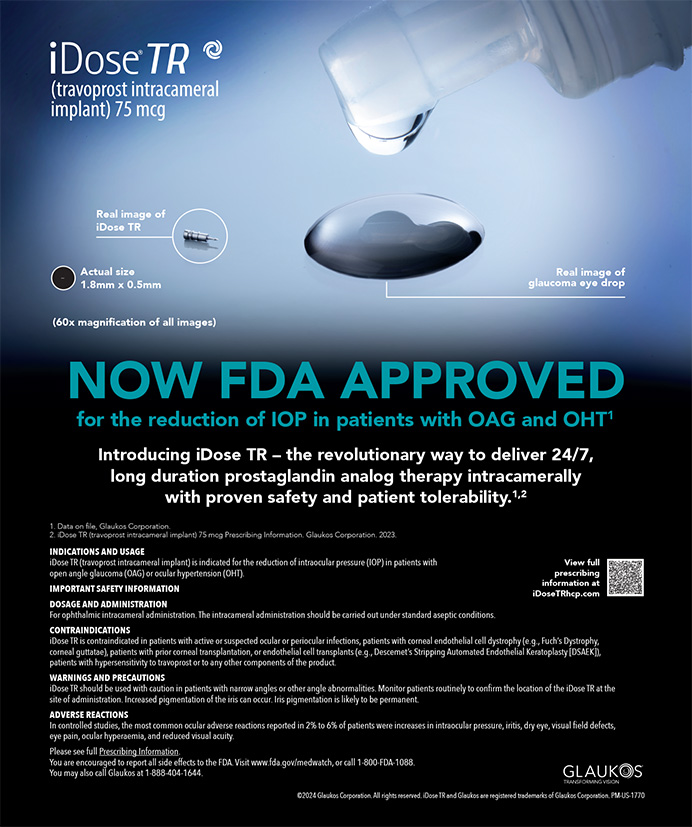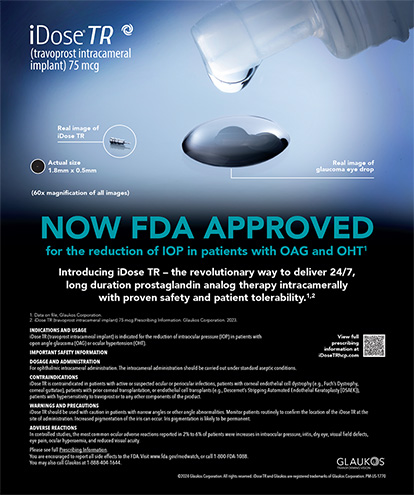Following LASIK surgery, patients experience a significant reduction in corneal sensation because the nerves that supply feeling to the eye are severed when the flap is cut. We know, however, that the nerves regrow, and that there is an eventual return of sensation and tear production following laser surgery. It has been shown that the reduction in sensation is most significant early in the postoperative period, and that it improves with time.
Studying hinge position
The purpose of the original study that my colleagues and I conducted was to investigate the effect of hinge position on the loss of corneal sensation associated with dry eye following LASIK. The premise of the study was that the nerves enter the eye at 3 and 9 o'clock, and that preserving the nasal hinge would preserve half of the innervation of the eye. We followed these patients looking at sensation; every patient underwent LASIK in both eyes, one eye with a superior hinge and one eye with a nasal hinge. At the 6-month follow-up, we found that the eyes with the superior hinges continued to have a reduction in tear production and a statistically significant decrease in corneal sensation, compared to the eyes with nasal hinges. The tear production, corneal sensation, and corneal staining of the nasal hinge eyes were statistically unvaried from what they were preoperatively. Therefore, the eyes with the nasal hinges had returned to their preoperative baseline at 6 months, and the eyes with the superior hinges continued to have loss of feeling and decreased tear production and staining that was far greater than they had had preoperatively. To clarify, the nasal hinges produced no long-term effect, while dry eye and a loss of sensation in the superior hinge eyes continued at 6 months, although they continued to improve. However, we are unsure whether corneal sensation ever returns completely with superior hinge flaps, but we imagine that it does.
Almost every patient who undergoes LASIK experiences dry eye with a loss of sensation. This is very pronounced at 1 week—as high as 80% reduced from preoperative values. Studies have shown that at 1 week, Schirmer testing is decreased, and the tear film breakup time is shortened. There are many different parameters that have been studied to prove that dry eye occurs following LASIK, and that it affects almost every patient. In some patients, however, dry eye is so mild that they simply complain of a little foreign body sensation, or they may say that they feel as if they have a dirty contact lens in their eye for the first week or so. Eventually, patients' sensation returns to normal and they start feeling better.
Study Implications
I think that the findings of this study make the statement that surgeons should, when possible, make a nasal hinge flap for patients who have preoperative dry eye, or a risk of dry eye following surgery (Figure 2A and B). I feel that with using the nasal hinge, the majority of patients at 6 months are going to recover function, that they are going to feel better and see better, and that the severity of their dry eye is going to lessen. I think the other lesson we learned is that recovery does take at least 6 months, and in some patients it might take a year before they return to their normal baseline. For patients who complain of dry eye and who are uncomfortable after LASIK, surgeons can reassure them with statistics that indicate that their condition is temporary and that they will improve with time.
Additional Findings
The most severe form of dry eye following LASIK is corneal staining, in which patients actually experience a physical disruption of their cornea. This physical disruption causes loss of vision, vision fluctuation, and irritation, and we found that five out of 52 patients had this type of problem with the superior hinge flap, which may explain a lot of the visual fluctuations many of these patients have following LASIK. Therefore, patients who are experiencing visual fluctuations and discomfort after LASIK should concentrate on maximizing their tear film, because dry eye may be the culprit, rather than the laser.
THE NEXT STEP
We are currently investigating the effect of the width of the hinge, feeling that a wider hinge will produce greater innervation of the cornea. If this is actually the case, we will present our findings at the ASCRS meeting in June of this year. We feel that the larger the hinge, the better preserved are the nerves in the eye. The hinge is the conduit that allows the nerves to enter the flap. We have 3-month data so far, which looks as though it will be statistically significant. We are also waiting for the 1-year data on the hinge position study, which we will also present at the ASCRS meeting.


